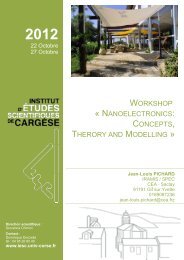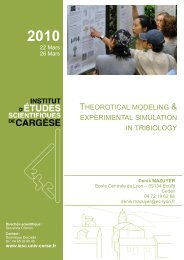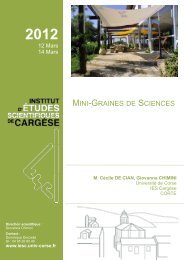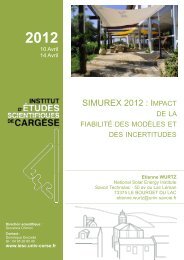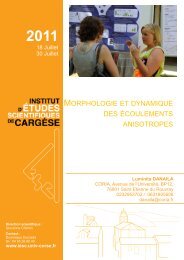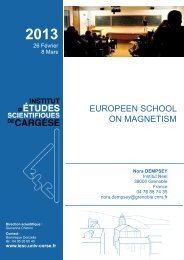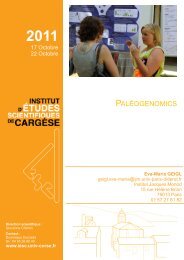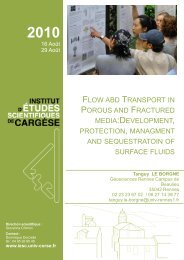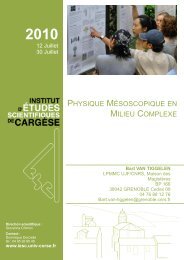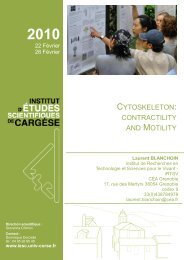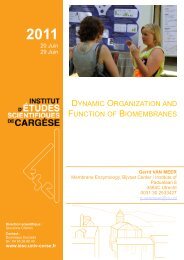Mathias FINK - Institut d'études scientifiques de Cargèse (IESC)
Mathias FINK - Institut d'études scientifiques de Cargèse (IESC)
Mathias FINK - Institut d'études scientifiques de Cargèse (IESC)
You also want an ePaper? Increase the reach of your titles
YUMPU automatically turns print PDFs into web optimized ePapers that Google loves.
disor<strong>de</strong>red media leads to substantial changes in the photonic properties, compare to that of bulk<br />
materials. Changes in the local <strong>de</strong>nsity of optical states (LDOS) influence spontaneous emission as<br />
well as absorption of light (weak coupling regime or Purcell effect). Disor<strong>de</strong>r also influences the<br />
intrinsic spatial coherence that can be <strong>de</strong>scribed by the concept of cross <strong>de</strong>nsity of states (CDOS). A<br />
reduction of the intrinsic spatial coherence can reveal the spatial localization of mo<strong>de</strong>s in a<br />
complex system. The strong coupling regime can even be reached between a resonant scatterer (or<br />
emitter) and an An<strong>de</strong>rson localized mo<strong>de</strong>. In the lecture we will focus on the basic concepts used to<br />
<strong>de</strong>scribe the different interaction regimes, and illustrate the main trends based on numerical<br />
simulations and experiments. We will also discuss some analogies between different kind of<br />
measurements that are actually driven by the same features of the un<strong>de</strong>rlying structure of the optical<br />
eigenmo<strong>de</strong>s.<br />
Pr. Didier Felbacq<br />
Universality and scaling in topological metamaterials<br />
The presentation will <strong>de</strong>al with electromagnetic wave propagation in a mo<strong>de</strong>l metamaterial ma<strong>de</strong> of<br />
dielectric rods. The scatterers are such that they present a double resonance (magnetic and electric)<br />
in such a way that conduction bands are opened. A low frequency analysis will show that the<br />
behavior of the system can be <strong>de</strong>scribed by resonant (dispersive) electromagnetic parameters ε and<br />
μ. The bands have universal features with respect to symmetry and scaling, that will be explored<br />
numerically. The link with photonic topological insulators will be discussed as well as the transition<br />
to An<strong>de</strong>rson localization.<br />
Dr. Sylvain Gigan<br />
Matricial approach to optical wavefront engineering<br />
The randomness of the refractive in<strong>de</strong>x and/or the position of the scatterers blur the images in<br />
biological tissues. OCT by selecting singly backscattered photons is a first approach that allows<br />
overcoming this problem. Even with incoherent sources the OCT signal exhibits a speckle<br />
distribution. Despite of the speckle in the images the Full Field OCT (FFOCT) approach that we<br />
have <strong>de</strong>veloped allows to reveal the tissue morphology at the micron scale and starts to be a<br />
valuable tool in intra operative surgery. Sometimes the morphology is not enough to characterize<br />
the tissue, so we will examine the basic nature of the signal and what kind of supplementary<br />
information can be extracted from the OCT data such as local refractive in<strong>de</strong>x, <strong>de</strong>nsity of scatterers<br />
and elasticity map. Finally (because we are in Cargese !) I will shows how FFOCT is used to count<br />
and characterize, through their Brownian trajectories, viruses in see water.<br />
Dr. Stefan Enoch<br />
Scaling up the holes : Towards Seismic metamaterials<br />
It has been recently suggested that structured media can bend light trajectories the wrong way,<br />
making a flat convergent superlens, or even <strong>de</strong>tour light around an objsect, making an invisibility<br />
cloak. Such electromagnetic metamaterials introduced by Sir John Pendry during the last <strong>de</strong>ca<strong>de</strong><br />
have counterparts in acoustics. In this talk, I will focus my attention on certain type of surface<br />
waves : flexural (Lamb) waves propagating within thin elastic metamaterial plates which have been<br />
experimentally studied this year by research groups in Wegener in Karlsruhe, Van<strong>de</strong>nberghe in<br />
Marseille, with applications thought in cloaking, and Sebbah’s group in Paris, where the dynamics<br />
of a flat lens for Lamb waves has been unveiled. Interestingly, control of flexural waves opens a<br />
route towards seismic metamaterials. First experiments performed by multinational company<br />
Menard this year near the French cities of Grenoble and Lyon <strong>de</strong>monstrate that one can shield or<br />
even focus a seismic wave of magnitu<strong>de</strong> 4 on the Richter scale through an array of meter sized



